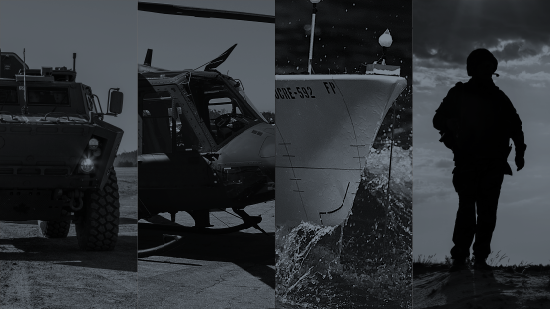
On June 1 and 2, 2022, National Research Council of Canada (NRC) experts from the Aerospace, Security and Disruptive Technologies, Automotive and Surface Transportation, Digital Technologies, and Ocean, Coastal and River Engineering research centres are participating in CANSEC, Canada’s largest global defence and security trade show.
After a 2-year interruption due to the coronavirus pandemic, the event, which has been held annually by the Canadian Association of Defence and Security Industries (CADSI), invites exhibitors to showcase leading-edge technologies, products and services for the defence and security industry.
As the Government of Canada’s largest research and development organization, the NRC conducts research and technology development for clients and partners delivering security and defence solutions that span air, land and sea transportation, infrastructure and buildings, controlled goods and intelligence.
In addition, with the goal of further advancing R&D solutions in defence and security, an evolutionary Memorandum of Understanding between the NRC and one of its largest collaborators, the Department of National Defence (DND), was signed on November 22, 2021. This renewed 25-year arrangement reiterates the importance of sustainability and national strategic defence capabilities at a time where disruptive innovations such as quantum and AI have become key differentiators for nations. Built on more than 100 years of collaboration, this strategic partnership will become even more critical to Canada’s defence forces, the defence and security industry and Canadians.
Discover some of the innovative defence and security solutions developed by the NRC below and by watching our dynamic video
On display at CANSEC: Wind tunnel model of the Arctic Offshore and Patrol Vessel
Landing a helicopter on the deck of a moving ship is not as simple as it may seem. Pilots have to take into account highly-turbulent airflows over the deck as well as the ship’s heaving or pitching motion due to different sea states. The NRC is collaborating with DND and Defence and Research Development Canada on a wind tunnel test program to quantify the shipboard environment for de-risking and reducing costs of at-sea flight trials. The NRC is currently supporting operations on Canada’s newly accepted Arctic Offshore and Patrol Vessel, including the first-of-class flight trial that took place aboard the HMCS Harry Dewolf in summer 2021.
On display at CANSEC: Defence and security mobility solutions
The NRC has created digital twins of wheeled and tracked military vehicles using a combination of laboratory testing in NRC’s Structural Dynamics Facility, field testing and modeling, and simulation techniques. Digital twins allow for rapid analysis of performance and safety characteristics when changes to the vehicle configuration are being considered, or when a mobility/traversability assessment is required over a unique terrain. The NRC works with DND to develop digital twins of varying complexity for a range of vehicle platforms, from ultra-lightweight combat vehicles to heavy logistics and armoured vehicles. The NRC is also working on related research topics involving off-road vehicle mobility. For example, remote terrain sensing techniques for real-time mobility performance feedback to drivers or for autonomous off-road vehicle applications, and support for the ongoing development of the Next Generation NATO Reference Mobility Model.
On display at CANSEC: Multifunctional nanocomposites
The NRC is helping to develop the next generation of protective, multifunctional materials for military and first responders. These multifunctional nanocomposites are lightweight and conformable yet combine protection against fire, impact and electromagnetic interference. Our NRC researchers continue to work with industry and DND on cutting-edge material solutions for defence and security applications.
On display at CANSEC: Electronic nose
The NRC has developed a low-cost sensor array with minimal power requirements for the detection of airborne chemicals. High purity, commercially available carbon nanotubes combined with affordable polymers result in a sensor array that responds uniquely to a variety of chemicals of concern. This scalable, trainable system has the potential to alert military, first responder and public safety communities of chemical and biological hazards more quickly and affordably than is currently possible.
On display at CANSEC: Smart molded parts
Using a new molecular ink, a printable ink which possesses conductive properties, e2ip technologies, in collaboration with the NRC, have developed an innovative technology that integrates electronic circuits and sensors onto 2D sheets of thin plastic. These are formed and over-molded in protective plastic to create smart surfaces and parts.
This allows the manufacturing of sleek multi-functional user interfaces that are lighter, more compact and can be made at a lower cost. This disruptive technology is set to completely transform the surfaces we touch and allow us to reimagine the way we interact with the world around us.
The Multimedia Analytic Tools for Security (MATS) program at the NRC brings together end-users and industry partners to create machine learning and AI-based analytic solutions that aid in finding critical information with greater precision and speed. The main deliverables of the program are software algorithms and prototypes that advance solutions for national defence, security and public safety analysts.
As part of the maintenance and modernization of the Canadian fleet, DND enlisted the help of the NRC’s Ocean, Coastal and River Engineering Research Centre to design, build and test a new autopilot control system which, when engaged, automatically adjusts and compensates for any disturbance that could affect the submarine’s set course through the water. The NRC’s modelling services proved ideal for testing the upgraded autopilot system as it allowed DND to see the trial software in action, since the model submarine could be maneuvered on command. In addition, the NRC offers expertise in creating technical specifications and procurement strategies, evaluating and implementing engineering changes, and evaluating performance improvements using digital simulation and tank tests.
Through research in arctic regions, we focus on providing safer and more efficient shipping routes, improved oil spill detection, countermeasures, clean-up methods in ice and ensuring more reliable ice road operations. Our efforts increase the likelihood of survivability in the event of an emergency evacuation from vessels in ice-covered waters and from offshore platforms.
